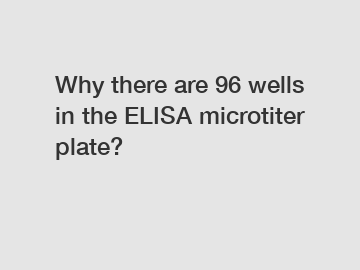Why there are 96 wells in the ELISA microtiter plate?
Have you ever wondered why there are 96 wells in an ELISA microtiter plate? If you're an experienced scientist or researcher, you may have come across this question before. In this blog post, we're going to explore the reasons behind this specific number of wells and why it's crucial for the success of ELISA assays.
First of all, let's talk about what ELISA actually stands for. ELISA stands for Enzyme-Linked Immunosorbent Assay, and it is a widely used method for detecting and quantifying proteins, antibodies, peptides, and hormones in biological samples. It is a crucial tool in the field of immunology and is used in a variety of applications, from diagnosing diseases to monitoring the progression of treatments.
Now, back to the 96 wells in the microtiter plate. The number of wells in an ELISA plate is not arbitrary; it is specifically chosen to ensure the efficiency and accuracy of the assay. The 96-well format is widely used in ELISA assays because it allows for a high throughput of samples while still maintaining a compact and manageable size. With 96 wells, researchers can test multiple samples simultaneously, saving time and resources.

The 96-well format also allows for easy automation of the assay, which is essential for reproducibility and consistency in research. Automated systems can precisely dispense reagents into each well, ensuring that each sample is treated the same way and reducing the risk of human error. This level of automation is essential for large-scale studies and clinical trials where thousands of samples need to be tested.
Furthermore, the 96-well format allows for easy comparison and analysis of samples. By arranging samples in a grid pattern, researchers can easily track which samples have been tested and analyze the results in a systematic way. This makes it easier to identify patterns and trends in the data, leading to more meaningful and reliable conclusions.
In addition to its practical advantages, the 96-well format is also cost-effective. By testing multiple samples in a single plate, researchers can reduce the amount of reagents and materials needed for each assay. This not only saves money but also reduces waste and helps to conserve resources.
Overall, the 96 wells in an ELISA microtiter plate are essential for the success of the assay. By allowing for high throughput, easy automation, efficient analysis, and cost-effective testing, the 96-well format has become the standard in the field of immunology. Whether you're a seasoned researcher or a newcomer to the world of ELISA, understanding the significance of the 96 wells in the microtiter plate is key to conducting successful and reliable experiments.
In conclusion, the 96 wells in an ELISA microtiter plate may seem like a small detail, but they play a crucial role in the efficiency and accuracy of the assay. By providing a high throughput, easy automation, efficient analysis, and cost-effective testing, the 96-well format has become indispensable in the field of immunology. So next time you're setting up an ELISA experiment, remember the importance of those 96 wells and how they contribute to the success of your research.
If you are looking for more details, kindly visit cell culture pipettes, erlenmeyer flask used for, flask use chemistry.


